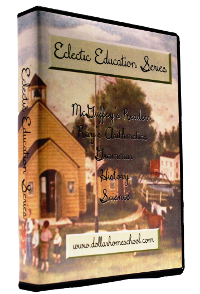We live in a semi-arid climate in the West, so we are surrounded by yucca plants!
 |
| Yucca blossom dissection with labels |
Then, for her essay this week, I asked her to research and write about the usefulness of this desert plant. This is what she wrote:
Yucca Plant
by Ellie, age 12
The yucca plant is very useful. The Pueblo Indians used it for food, rope, paint brushes, and shampoo. The fruit could be eaten raw, dried, baked or boiled (it tastes kind of like potatoes). Sometimes they made the pulp mixed with berries into cakes that were dried.
The stalks were eaten also. The stalks have a fiber that was used to make rope (sometimes they put human or animal hair or even feathers into it). The stalks would be soaked in cold water and pounded with a stone that would separate the fiber which would be braided together after that. The stalks could also be used as paint brushes (just bite the tip and it will fray).
Shampoo came from the roots! It was first pounded and then mixed into cold water. This would create suds that the Indians used to wash with.
Many Indian Tribes used the yucca for sacred ceremonies. Native Americans also used it as one of the main dyeing substances. If you burn yucca leaves (stalks) to ashes and put these in bread dough, the bread will turn blue and very thin. The tips were also used for needles.
The pronuba moth is necessary to the plant. The pronuba (or yucca moth) needs the plant as much as the plant needs it. The pronuba pollinates the plant while it lays its babies (or larvae). The larvae eat the maturing fruit and, when they are at the pupating stage, crawl down the stem and go into the ground.
Nowadays we have a root beer with yucca in it (yucca creates foam).
Yucca is used for healing cuts, sunburns, scratches and dry cuticles. If you have arthritis or rheumatism take a yucca root and boil it for about half an hour and then drink it as tea. I can guarantee it will relieve you!































0 comments :
Post a Comment